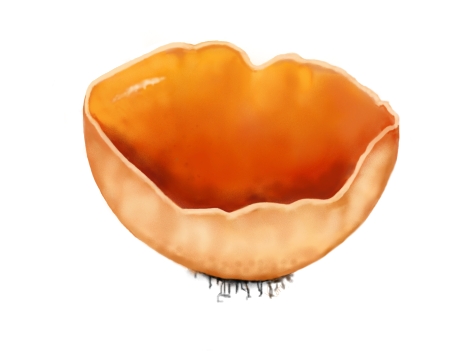Morphology of the Orange Peel...Fungus.
The Mycelium and Hyphae
When it comes to determining which kingdom an organism belongs to, the fungi are easy to classify due to one universal structure: the mycelium. The mycelium of a fungus is a net-like structure composed of hyphae, which are thread-like cells. These hyphae are particularly important when it comes to nutrition, as these structures release the exoenzymes that allow fungal species like Aleuria aurantia to decompose organic material.
Specifically, fungal hyphae possess
chitinous cell walls, which exist outside the cells'
cytoplasm and plasma membranes. The hyphae of the
Orange Peel Fungus have structues called septa, which are
cross-walls that link the individual cells. The main
advantage of septa involves cell transport: Pores of the
septa allow for the exchange of ribosomes, mitochondria, and
nuclei between cells.
The Ascocarp
Some members of the Phylum Ascomycota, including the Orange Peel Fungus, have distinct fruiting bodies called ascocarps. In fact, it is this particular structure of the Orange Peel Fungus that gives it its name; the ascocarp of the Orange Peel Fungus is bright orange and resembles an orange peel.
The Asci
Hyphae that are part of the ascocarp may transform into asci, which are structures that house the sexual life stages of the Orange Peel Fungus. Within each asci are eight ascospores.
Each asci of the Orange Peel Fungus has an operculum on its surface, which is similar to a lid. This operculum opens when the ascospores are mature. Not all species of fungi with asci possess this structure.
The Conidiophores and Conidia
The asexual form of reproduction in the Orange Peel Fungus occurs in structures called conidiophores. Conidia, which are haploid spores, are formed in the conidiophores via mitosis. When conditions are appropriate, conidia are released from these conidiophores into the environment.
To compare the morphology of the Orange Peel Fungus with the morphologies of other specimens of fungi, click here, here, and here.